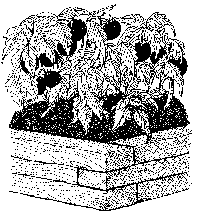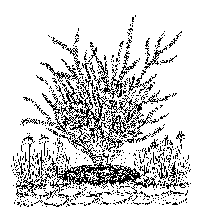 What is Compost?
What is Compost?
 Using Compost
Using Compost
What is Compost?
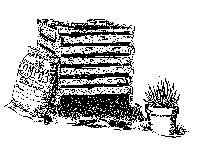 Compost is produced when organic matter, such as garden and lawn waste, is
broken down by bacteria and fungi. When added to soil it improves soil
structure; sandy soils will hold water better while clays will drain faster.
Compost also promotes a biologically healthy soil by providing food for
earthworms, soil insects, and beneficial microorganisms.
Compost is produced when organic matter, such as garden and lawn waste, is
broken down by bacteria and fungi. When added to soil it improves soil
structure; sandy soils will hold water better while clays will drain faster.
Compost also promotes a biologically healthy soil by providing food for
earthworms, soil insects, and beneficial microorganisms.
When you purchase compost, buy it from a reliable source. Large-scale
commercial composting is a controlled, high-temperature process that destroys
weed seeds and disease organisms, and produces a relatively sterile product. You
can also make your own compost with yard and kitchen wastes using the Compost
Bin or Compost Barrel.
Compost contains micronutrients beneficial to plant health, but is not
considered to be a fertilizer as it is low in nitrogen, phosphorus, and
potassium. The amount of nitrogen in compost is low compared to organic
materials, such as manure. Since nitrogen in the plant waste is lost during the
composting process, some nitrogen is also incorporated into organic compounds
and released slowly after the compost is applied to the soil.
Return to Table of Contents
Compost contains an organic material called humus which assists the soil in
holding nutrients. Humus lessens the need for chemical fertilizers and helps
prevent leaching of nitrogen into groundwater. Humus rich soil also promotes
healthy plants which are less susceptible to diseases and insect pests. This can
reduce the need for chemical pesticides.
Compost reduces erosion by improving soil structure. Better drainage allows
water to flow into lower soil layers, rather than puddle on top and run off.
Improved soil structure also helps the growth of roots which hold soil in place.
Finally, compost recycles garden wastes to benefit the environment.
Return to Table of Contents
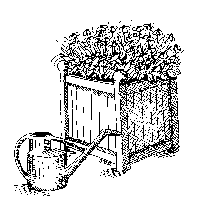 Using Compost
Using Compost
Compost can be used to make a good
container gardening medium. First, strain the
compost through a sieve to eliminate large particles. Then mix two parts
compost, one part garden loam, and one part perlite or sand. Add a tablespoon
each of phosphate and potash for each pot of mixture. You can also substitute
compost for peat moss in other suggested potting mixtures.
Return to Table of Contents
If you produce large amounts of compost, spread about 2 inches over your entire
garden annually and work it 6 to 8 inches into the soil. More than 2 inches at
one time may encourage grubs. As an alternative to compost, you can till 3 to 4
inches of shredded, uncomposted leaves into your garden or flower bed in the
fall. The leaves will decompose during winter and enrich the soil.
If your supply of compost is small, use it with transplants. Dig the hole for
your transplant and mix a trowel of compost into the backfill. The compost will
loosen the soil for the young plant's roots and also provide it with
micronutrients.
Compost is not as effective for a mulch, as weed seed tends to grow rapidly
in it.
Return to Table of Contents
The purpose of intensive gardening is to harvest the most produce possible from
a given space. The key to its success is fertile soil, high in organic matter.
Humus- rich compost holds extra nutrients in the soil that might otherwise be
leached out. It provides food for earthworms and beneficial microorganisms, and
allows for deep root penetration, permitting closer spacing of plants.
Raised beds are basic to intensive gardening. You can create a raised bed by
first mixing 2 inches of compost with the top 6 to 8 inches of garden soil. Then
build beds by mounding soil from the pathways into raised beds approximately 8
to 12 inches high and 3 to 4 feet wide. Heavily mulch the pathways with wood
chips to eliminate weeds. Repeat this every year. Or build wooden frames around
the beds to make them permanent and enrich the contained soil with compost
annually.
Return to Table of Contents
Add compost to the soil around your shrubs and trees. In late spring, place
about 1 inch of compost around the plants. Cover this with a mulch of shredded
pine needles, straw, bark chips, or leaves 2 to 3 inches deep. The humic acid
from the compost and decomposing mulch will penetrate the soil and change its
structure. This will improve the moisture retention, aeration, and fertility of
the soil around your trees and shrubs.
Return to Table of Contents
Incorporating compost into soil is an excellent way to establish or renovate a
lawn. Spread about 2 inches of compost over the planned lawn area. Till this
into the soil before laying turf or planting grass seed. Do not spread compost
on an established lawn, however, as this may contribute to thatch buildup. Too
much thatch can lead to disease, insect problems, and temperature and drought
stress.
Return to Table of Contents
![]() Gardeners' Corner
Kids'
Garden
Sustainable Garden
Contact Us
Gardeners' Corner
Kids'
Garden
Sustainable Garden
Contact Us![]()
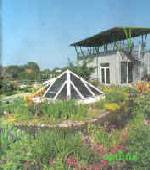

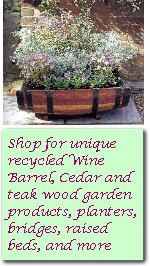
 Compost is produced when organic matter, such as garden and lawn waste, is
broken down by bacteria and fungi. When added to soil it improves soil
structure; sandy soils will hold water better while clays will drain faster.
Compost also promotes a biologically healthy soil by providing food for
earthworms, soil insects, and beneficial microorganisms.
Compost is produced when organic matter, such as garden and lawn waste, is
broken down by bacteria and fungi. When added to soil it improves soil
structure; sandy soils will hold water better while clays will drain faster.
Compost also promotes a biologically healthy soil by providing food for
earthworms, soil insects, and beneficial microorganisms. Using Compost
Using Compost
